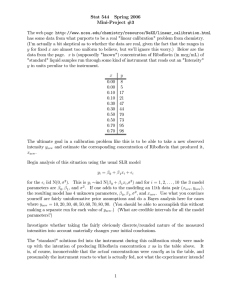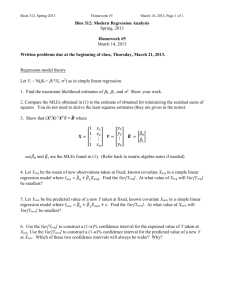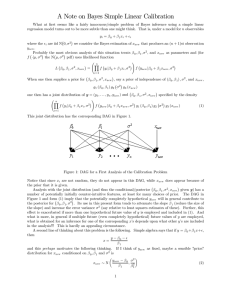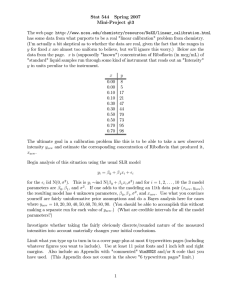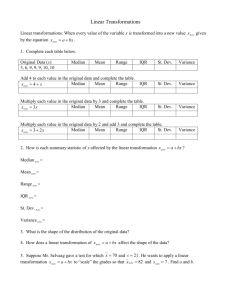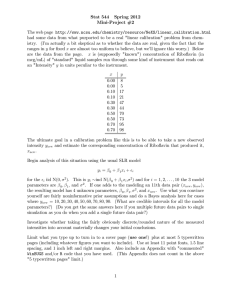EXAMPLE 1
advertisement
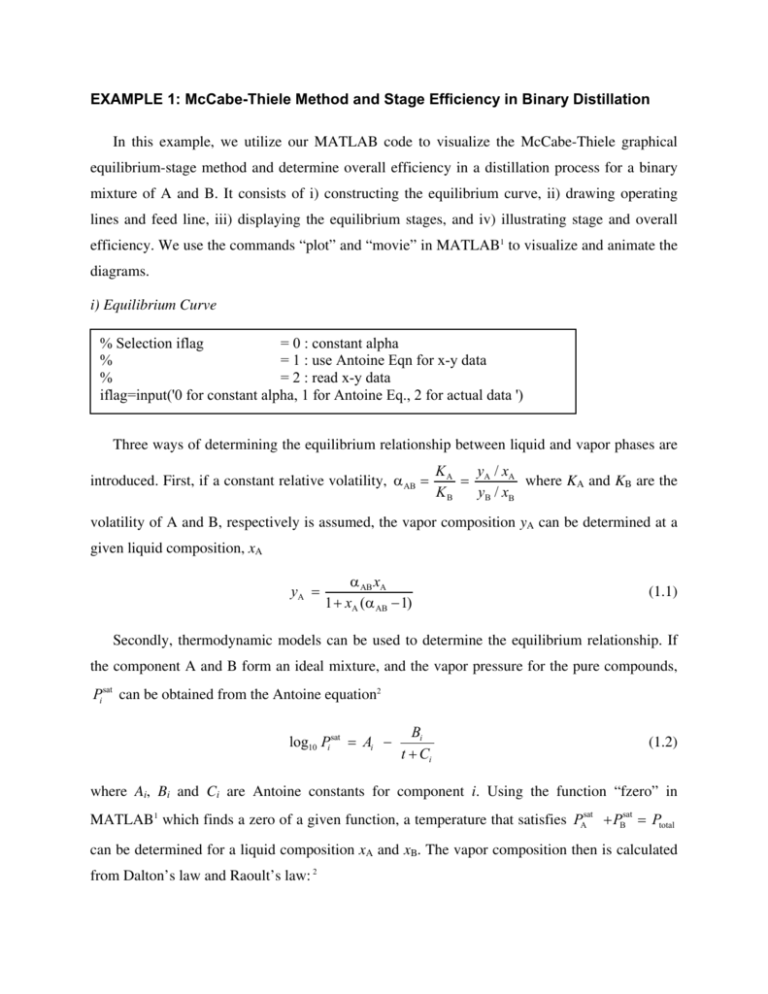
EXAMPLE 1: McCabe-Thiele Method and Stage Efficiency in Binary Distillation
In this example, we utilize our MATLAB code to visualize the McCabe-Thiele graphical
equilibrium-stage method and determine overall efficiency in a distillation process for a binary
mixture of A and B. It consists of i) constructing the equilibrium curve, ii) drawing operating
lines and feed line, iii) displaying the equilibrium stages, and iv) illustrating stage and overall
efficiency. We use the commands “plot” and “movie” in MATLAB1 to visualize and animate the
diagrams.
i) Equilibrium Curve
% Selection iflag
= 0 : constant alpha
%
= 1 : use Antoine Eqn for x-y data
%
= 2 : read x-y data
iflag=input('0 for constant alpha, 1 for Antoine Eq., 2 for actual data ')
Three ways of determining the equilibrium relationship between liquid and vapor phases are
introduced. First, if a constant relative volatility, α AB =
KA
y /x
= A A where KA and KB are the
KB
yB / xB
volatility of A and B, respectively is assumed, the vapor composition yA can be determined at a
given liquid composition, xA
yA =
α AB xA
1 + xA (α AB − 1)
(1.1)
Secondly, thermodynamic models can be used to determine the equilibrium relationship. If
the component A and B form an ideal mixture, and the vapor pressure for the pure compounds,
Pi sat can be obtained from the Antoine equation2
log10 Pi sat = Ai −
Bi
t + Ci
(1.2)
where Ai, Bi and Ci are Antoine constants for component i. Using the function “fzero” in
B
MATLAB1 which finds a zero of a given function, a temperature that satisfies PAsat + PBsat = Ptotal
can be determined for a liquid composition xA and xB. The vapor composition then is calculated
B
from Dalton’s law and Raoult’s law: 2
PAsat
yA =
xA Ptotal
(1.3)
Finally, the liquid and vapor compositions, xA and yA can directly be read from the actual data.
With the liquid and vapor compositions in equilibrium xA and yA, the equilibrium curve, i.e. the y
– x diagram is plotted.
figure(1), clf
for i = 1:itotal
xnew=x+dx;
if iflag==0
% Contant alpha
ynew=a*xnew/(1+xnew*(a-1));
elseif iflag==1
% Using Antoine Eq. (2)
t=fzero('antoine',tguess,optimset('disp','iter'),xnew,a1,b1,c1,a2,b2,c2,Ptotal);
tguess=t;
ynew=pvapor(a1,b1,c1,t)/Ptotal*xnew
else
% Actual Data
xnew=xdata(i+1);
ynew=ydata(i+1);
end
plot([x,xnew],[y,ynew],'b','LineWidth',2) % Plot y vs. x diagram (eq. curve)
hold on
title('McCabe-Thiele Method')
xlabel('x')
ylabel('y')
axis([0 1 0 1])
axis('square')
plot([x xnew], [x xnew], 'b--','LineWidth',2)
hold on
Frames(:,i)=getframe;
x=xnew;
y=ynew;
end
ii) Operating Lines and Feed Line
Under the assumption of constant molar overflow, i.e. constant molar liquid and vapor rates,
L and V in the rectifying section (and L and V in the stripping section), the operating lines for
the rectifying and stripping sections can be displayed using
2
⎛ R ⎞
⎛ 1 ⎞
y =⎜
⎟x+⎜
⎟ xD
⎝ R +1⎠
⎝ R +1⎠
(1.4)
⎛ V +1⎞ ⎛ 1 ⎞
y = ⎜ B ⎟ x − ⎜ ⎟ xB
⎝ VB ⎠ ⎝ VB ⎠
(1.5)
where R = L/D and VB = V / B are the reflux ratio and boil-up ratio, and D and B are the distillate
and bottoms product rate, respectively. In Eqs. (1.4) and (1.5), xD and xB are the overhead
product and bottom product composition, respectively.
Meanwhile, the q-line which describes the feed condition can also be displayed using
⎛ q ⎞ ⎛ zF ⎞
y =⎜
⎟ x −⎜
⎟
⎝ q −1 ⎠ ⎝ q −1 ⎠
where q =
(1.6)
L−L
is the ratio of the increase in molar flux rate across the feed stage to the molar
F
feed rate, F, and zF is the feed composition. Once any two of these three parameters, the reflux
ratio, R, boil-up ratio VB and feed condition q are specified, the operating lines from Eqs. (1.4)
and (1.5), and the q-line from Eq. (1.6) are uniquely determined.
iii) Theoretical Equilibrium Stages
Once the equilibrium curve, operating lines and feed line are drawn, the equilibrium composition
at each stage is determined by the McCabe-Thiele method. Starting from the distillate xD (or
bottoms product xB), the procedure for plotting the graphical solution is as follows:
a. Draw a horizontal line from (xD, xD) to the equilibrium curve
b. Drop a vertical line to the operating line
c. Repeat a and b until x reaches xB.
When actual data is used for the equilibrium curve, the Matlab interpolation function called
“interp1” is used to find the intersection points in procedure a.1 The transfer in the operating line
from the rectifying section to stripping section is made when the liquid composition, x passes
that of the intersection of the two operating lines and feed line.
3
while x >= x_B
% loop for stepping
ynew=y
% using constant alpha for eq. relation
if iflag==0
xnew=ynew/(a-ynew*(a-1));
% using Antoine Eq. (2) for eq. relation
elseif iflag==1
t=fzero('antoine2',tmid,optimset('disp','iter'),ynew,a1,b1,c1,a2,b2,c2,Ptotal);
xnew=ynew*Ptotal/pvapor(a1,b1,c1,t);
% using actual data for eq. relation
else
xnew=interp1(ydata,xdata,ynew);
end
plot([x,xnew],[y,ynew],'r','LineWidth',2) % a. Draw a horizontal line to the eq. curve
hold on
Frames(:,i)=getframe;
pause
i=i+1;
x=xnew
if x >= x_c
%if x >= z
% using the op. line for rectifying section
y=LoverV_D*x+x_D/(R+1)
else
% using the op. line for stripping section
y=LoverV_B*x-x_B/V_B
end
plot([xnew,x],[ynew,y],'r','LineWidth',2) % b. Draw a vertical line to the op. line
hold on
Frames(:,i)=getframe;
pause
% calculating # of stages
if x >= x_B
nstage=nstage+1
else
nstage=nstage+x/x_B
end
end
% c. Repeat a and b until x reaches x_B
iv) Stage and Overall Efficiency
Using the Murphree vapor efficiency, EMV for each stage, the actual vapor composition can
be obtained as2,3
yi = yi +1 + EMV ( yieq − yn +1 )
(1.7)
4
where i+1 is the stage below and yieq is the composition in the vapor in equilibrium with the
liquid composition leaving stage i, xi. The overall efficiency, Eo is determined by the ratio of the
number of the theoretical equilibrium stages to that of the actual stages, i.e. Eo = N t / N a .
REFERENCES
1. Pratap, R., Getting Started with MATLAB, A Quick Introduction for Scientists and
Engineers (Oxford University Press, 2002).
2. McCabe, W. L., Smith, J. C. and Harriott, P., Unit Operations of Chemical Engineering
(McGraw Hill, 6th ed., 2000)
3. Seader, J.D. and Henley, E.J., Separation Process Principles (John Wiley & Sons, 1998)
Obtain equilibrium data
Thermodynamic Input
Constant relative volatility/ Antoine equation/
Actual data
• Step 1: Display y vs. x diagram (eq. curve)
Design Input
Reflux ratio & feed condition
or
Reflux ratio & boilup ratio
or
Boilup ratio & feed condition
• Step 2: Display operating lines and feed line
• Step 3: Determine theoretical equilibrium stages, Nt
• Horizontal line to equilibrium curve
• Vertical drop to operating line
Design Input
Murphree vapor efficiency, Emv
• Step 4: Display new stepping based on Emv
Determine actual stages Na and overall efficiency Eo
Figure 1.1. Flow chart of Example 1: graphical method for binary distillation
5
0.9
0.9
0.8
0.8
0.7
0.7
0.6
0.6
0.5
0.5
0.4
0.4
0.3
0.3
0.2
0.2
0.1
0.1
0
y
y
1
0
0.1
0.2
0.3
0.4
0.5
x
0.6
0.7
0.8
0.9
0
1
1
1
0.9
0.9
0.8
0.8
0.7
0.7
0.6
0.6
0.5
0.5
y
y
1
0.4
0.4
0.3
0.3
0.2
0.2
0.1
0.1
0
0
0.1
0.2
0.3
0.4
0.5
x
0.6
0.7
0.8
0.9
1
0
0
0.1
0.2
0.3
0.4
0.5
x
0.6
0.7
0.8
0.9
1
0
0.1
0.2
0.3
0.4
0.5
x
0.6
0.7
0.8
0.9
1
Figure 1.2. Snap shots of graphical output of Example 1: McCabe-Thiele method for binary
distillation of acetone and toluene. a) Equilibrium curve from Antoine equations, b) operating
lines and feed line for zA = 0.5, xD = 0.95, xB = 0.05, q = 0.5, R = 2, c) theoretical equilibrium
stages, and d) actual stages (shown in dashed line) with Emv = 0.7.
B
6
